Sustainable agriculture
Sustainable agriculture is farming in sustainable ways, which means meeting society's present food and textile needs, without compromising the ability for current or future generations to meet their needs.[1] It can be based on an understanding of ecosystem services. There are many methods to increase the sustainability of agriculture. When developing agriculture within sustainable food systems, it is important to develop flexible business process and farming practices.[2]
| Agriculture |
|---|
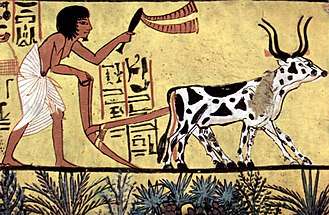 |
|
Categories
|
|
|
Agriculture has an enormous environmental footprint, playing an outsized role in causing climate change, water scarcity, land degradation, deforestation and other processes;[3] it is simultaneously causing environmental changes and being impacted by these changes.[4] Developing sustainable food systems, contributes to the sustainability of the human population. For example, one of the best ways to mitigate climate change is to create sustainable food systems based on sustainable agriculture. Sustainable agriculture provides a potential solution to enable agricultural systems to feed a growing population within the changing environmental conditions.[4]
History
In 1907 Franklin H. King in his book Farmers of Forty Centuries discussed the advantages of sustainable agriculture, and warned that such practices would be vital to farming in the future.[5] The phrase 'sustainable agriculture' was reportedly coined by the Australian agronomist Gordon McClymont.[6] The term became popular in the late 1980s.[7]
There was an international symposium on sustainability in horticulture by the International Society of Horticultural Science at the International Horticultural Congress in Toronto in 2002.[8] At the following conference at Seoul in 2006 the principles were discussed further.[9]
Definition
In the US National Agricultural Research, Extension, and Teaching Policy Act of 1977,[10] the term "sustainable agriculture" is defined as an integrated system of plant and animal production practices having a site-specific application that will, over the long term:
- satisfy human food and fiber needs[10]
- enhance environmental quality and the natural resource base upon which the agriculture economy depends[10]
- make the most efficient use of nonrenewable resources and on-farm resources and integrate, where appropriate, natural biological cycles and controls[10]
- sustain the economic viability of farm operations[10]
- enhance the quality of life for farmers and society as a whole.[10]
The British scholar Jules Pretty has stated several key principles associated with sustainability in agriculture:[11]
- The incorporation of biological and ecological processes such as nutrient cycling, soil regeneration, and nitrogen fixation into agricultural and food production practices.[11]
- Using decreased amounts of non-renewable and unsustainable inputs, particularly the ones that are environmentally harmful.[11]
- Using the expertise of farmers to both productively work the land as well as to promote the self-reliance and self-sufficiency of farmers.[11]
- Solving agricultural and natural resource problems through the cooperation and collaboration of people with different skills. The problems tackled include pest management and irrigation.[11]
It “considers long-term as well as short-term economics because sustainability is readily defined as forever, that is, agricultural environments that are designed to promote endless regeneration”.[12] It balances the need for resource conservation with the needs of farmers pursuing their livelihood.[13]
It is considered to be reconciliation ecology, accommodating biodiversity within human landscapes.[14]
Different viewpoints
There is debate on the definition of sustainability regarding agriculture. The definition could be characterized by two different approaches: an ecocentric approach and a technocentric approach.[15] The ecocentric approach emphasizes no- or low-growth levels of human development, and focuses on organic and biodynamic farming techniques with the goal of changing consumption patterns, and resource allocation and usage. The technocentric approach argues that sustainability can be attained through a variety of strategies, from the view that state-led modification of the industrial system like conservation-oriented farming systems should be implemented, to the argument that biotechnology is the best way to meet the increasing demand for food.[15]
One can look at the topic of sustainable agriculture through two different lenses: multifunctional agriculture and ecosystem services.[16] Both of approaches are similar, but look at the function of agriculture differently. Those that employ the multifunctional agriculture philosophy focus on farm-centered approaches, and define function as being the outputs of agricultural activity.[16] The central argument of multifunctionality is that agriculture is a multifunctional enterprise with other functions aside from the production of food and fiber. These functions include renewable resource management, landscape conservation and biodiversity.[17] The ecosystem service-centered approach posits that individuals and society as a whole receive benefits from ecosystems, which are called "ecosystem services".[16][18] In sustainable agriculture, the services that ecosystems provide include pollination, soil formation, and nutrient cycling, all of which are necessary functions for the production of food.[19]
It is also claimed sustainable agriculture is best considered as an ecosystem approach to agriculture, called agroecology.[20]
Ethics
Most agricultural professionals agree that there is a "moral obligation to pursue [the] goal [of] sustainability."[21] The major debate comes from what system will provide a path to that goal because if an unsustainable method is used on a large scale it will have a massive negative effect on the environment and human population.
Factors affecting sustainability
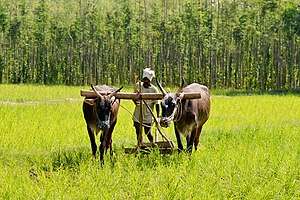
Practices that can cause long-term damage to soil include excessive tilling of the soil (leading to erosion) and irrigation without adequate drainage (leading to salinization).
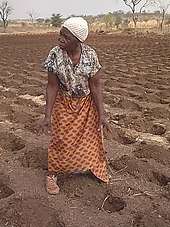
The most important factors for a farming site are climate, soil, nutrients and water resources. Of the four, water and soil conservation are the most amenable to human intervention. When farmers grow and harvest crops, they remove some nutrients from the soil. Without replenishment, land suffers from nutrient depletion and becomes either unusable or suffers from reduced yields. Sustainable agriculture depends on replenishing the soil while minimizing the use or need of non-renewable resources, such as natural gas or mineral ores.
A farm that is able to "produce perpetually", yet has negative effects on environmental quality elsewhere is not sustainable agriculture. An example of a case in which a global view may be warranted is application of fertilizer or manure, which can improve productivity of a farm but can pollute nearby rivers and coastal waters (eutrophication). The other extreme can also be undesirable, as the problem of low crop yields due to exhaustion of nutrients in the soil has been related to rainforest destruction. In Asia, the specific amount of land needed for sustainable farming is about 12.5 acres which includes land for animal fodder, cereal production as cash crop and other food crops. In some cases, a small unit of aquaculture is included (AARI-1996).
Nutrients
Nitrates
Possible sources of nitrates that would, in principle, be available indefinitely, include:
- recycling crop waste and livestock or treated human manure
- growing legume crops and forages such as peanuts or alfalfa that form symbioses with nitrogen-fixing bacteria called rhizobia
- industrial production of nitrogen by the Haber process uses hydrogen, which is currently derived from natural gas (but this hydrogen could instead be made by electrolysis of water using renewable electricity)
- genetically engineering (non-legume) crops to form nitrogen-fixing symbioses or fix nitrogen without microbial symbionts.
The last option was proposed in the 1970s, but is only gradually becoming feasible.[22][23] Sustainable options for replacing other nutrient inputs such as phosphorus and potassium are more limited.
Other options include long-term crop rotations, returning to natural cycles that annually flood cultivated lands (returning lost nutrients) such as the flooding of the Nile, the long-term use of biochar, and use of crop and livestock landraces that are adapted to less than ideal conditions such as pests, drought, or lack of nutrients. Crops that require high levels of soil nutrients can be cultivated in a more sustainable manner with appropriate fertilizer management practices.
Phosphate
Phosphate is a primary component in fertilizer. It is the second most important nutrient for plants after nitrogen,[24] and is often a limiting factor.[25] It is important for sustainable agriculture as it can improve soil fertility and crop yields.[26] Phosphorus is involved in all major metabolic processes including photosynthesis, energy transfer, signal transduction, macromolecular biosynthesis, and respiration. It is needed for root ramification and strength and seed formation, and can increase disease resistance.[27]
Phosphorus is found in the soil in both inorganic and organic forms[24] and makes up approximately 0.05% of soil biomass.[27] Phosphorus fertilizers are the main input of inorganic phosphorus in agricultural soils and approximately 70%–80% of phosphorus in cultivated soils is inorganic.[28] Long-term use of phosphate-containing chemical fertilizers causes eutrophication and deplete soil microbial life, so people have looked to other sources.[27]
Phosphorus fertilizers are manufactured from rock phosphate.[29] However, rock phosphate is a non-renewable resource and it is being depleted by mining for agricultural use:[26][28] peak phosphorus will occur within the next few hundred years,[30][31][32] or perhaps earlier.[33][34][35]
Soil
Land degradation is becoming a severe global problem. According to the Intergovernmental Panel on Climate Change: "About a quarter of the Earth’s ice-free land area is subject to human-induced degradation (medium confidence). Soil erosion from agricultural fields is estimated to be currently 10 to 20 times (no tillage) to more than 100 times (conventional tillage) higher than the soil formation rate (medium confidence)."[36] Over a billion tonnes of southern Africa's soil are being lost to erosion annually, which if continued will result in halving of crop yields within thirty to fifty years.[37] Improper soil management is threatening the ability to grow sufficient food. Intensive agriculture reduces the carbon level in soil, impairing soil structure, crop growth and ecosystem functioning,[38] and accelerating climate change.[38]
Soil management techniques include no-till farming, keyline design and windbreaks to reduce wind erosion, reincorporation of organic matter into the soil, reducing soil salinization, and preventing water run-off.[39][40]
Land
As the global population increases and demand for food increases, there is pressure on land as a resource. In land use planning and management, considering the impacts of land use changes on factors such as soil erosion can support long-term agricultural sustainability, as shown by a study of Wadi Ziqlab, a dry area in the Middle East where farmers graze livestock and grow olives, vegetables, and grains.[41]
Looking back over the 20th century shows that for people in poverty, following environmentally sound land practices has not always been a viable option due to many complex and challenging life circumstances.[42] Currently, increased land degradation in developing countries may be connected with rural poverty among smallholder farmers when forced into unsustainable agricultural practices out of necessity.[43]
Converting big parts of the land surface to agriculture have severe environmental and health consequences. For example, it leads to rise in Zoonotic disease like the Coronavirus disease 2019, by degrading natural buffers between humans and animals, reducing biodiversity and creating big groups of genetically similar animals[44][45].
Land is a finite resource on Earth. Although expansion of agricultural land can decrease biodiversity and contribute to deforestation, the picture is complex; for instance, a study examining the introduction of sheep by Norse settlers (Vikings) to the Faroe Islands of the North Atlantic concluded that, over time, the fine partitioning of land plots contributed more to soil erosion and degradation than grazing itself.[46]
The Food and Agriculture Organization of the United Nations estimates that in coming decades, cropland will continue to be lost to industrial and urban development, along with reclamation of wetlands, and conversion of forest to cultivation, resulting in the loss of biodiversity and increased soil erosion.[47]
Energy
In modern agriculture, energy is used in on-farm mechanisation, food processing, storage, and transportation processes.[48] It has therefore been found that energy prices are closely linked to food prices.[49] Oil is also used as an input in agricultural chemicals. The International Energy Agency projects higher prices of non-renewable energy resources as a result of fossil fuel resources being depleted. It may therefore decrease global food security unless action is taken to 'decouple' fossil fuel energy from food production, with a move towards 'energy-smart' agricultural systems including renewable energy.[49][50] The use of solar powered irrigation in Pakistan is said to be a closed system for agricultural water irrigation.[51]
The environmental cost of transportation could be avoided if people use local products.[52]
Water
In some areas sufficient rainfall is available for crop growth, but many other areas require irrigation. For irrigation systems to be sustainable, they require proper management (to avoid salinization) and must not use more water from their source than is naturally replenishable. Otherwise, the water source effectively becomes a non-renewable resource. Improvements in water well drilling technology and submersible pumps, combined with the development of drip irrigation and low-pressure pivots, have made it possible to regularly achieve high crop yields in areas where reliance on rainfall alone had previously made successful agriculture unpredictable. However, this progress has come at a price. In many areas, such as the Ogallala Aquifer, the water is being used faster than it can be replenished.
According to the UC Davis Agricultural Sustainability Institute, several steps must be taken to develop drought-resistant farming systems even in "normal" years with average rainfall. These measures include both policy and management actions:[53]
- improving water conservation and storage measures[53]
- providing incentives for selection of drought-tolerant crop species[53]
- using reduced-volume irrigation systems[53]
- managing crops to reduce water loss[53]
- not planting crops at all.[53]
Indicators for sustainable water resource development include the average annual flow of rivers from rainfall, flows from outside a country, the percentage of water coming from outside a country, and gross water withdrawal.[54]
Economics
Costs, such as environmental problems, not covered in traditional accounting systems (which take into account only the direct costs of production incurred by the farmer) are known as externalities.[11]
Netting studied sustainability and intensive agriculture in smallholder systems through history.[55]
There are several studies incorporating externalities such as ecosystem services, biodiversity, land degradation and sustainable land management in economic analysis. These include The Economics of Ecosystems and Biodiversity study and the Economics of Land Degradation Initiative which seek to establish an economic cost-benefit analysis on the practice of sustainable land management and sustainable agriculture.
Triple bottom line frameworks include social and environmental alongside a financial bottom line. A sustainable future can be feasible if growth in material consumption and population is slowed down and if there is a drastic increase in the efficiency of material and energy use. To make that transition, long- and short-term goals will need to be balanced enhancing equity and quality of life.[56]
Methods
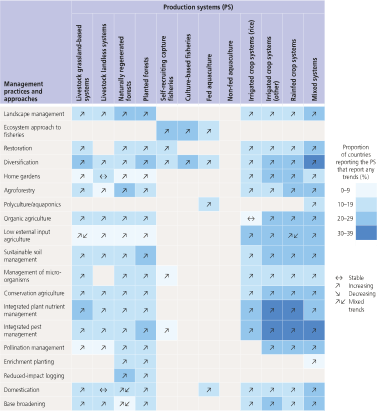
Other practices includes growing a diverse number of perennial crops in a single field, each of which would grow in separate season so as not to compete with each other for natural resources.[57] This system would result in increased resistance to diseases and decreased effects of erosion and loss of nutrients in soil. Nitrogen fixation from legumes, for example, used in conjunction with plants that rely on nitrate from soil for growth, helps to allow the land to be reused annually. Legumes will grow for a season and replenish the soil with ammonium and nitrate, and the next season other plants can be seeded and grown in the field in preparation for harvest.
Sustainable methods of weed management may help reduce the development of herbicide-resistant weeds.[58] Crop rotation may also replenish nitrogen if legumes are used in the rotations and may also use resources more efficiently.[59]
(NRCS_Photo_Gallery).tif.jpg)
There are also many ways to practice sustainable animal husbandry. Some of the tools to grazing management include fencing off the grazing area into smaller areas called paddocks, lowering stock density, and moving the stock between paddocks frequently.[60]
Intensification
An increased production is a goal of intensification. Sustainable intensification encompasses specific agriculture methods that increase production and at the same time help improve environmental outcomes. The desired outcomes of the farm are achieved without the need for more land cultivation or destruction of natural habitat; the system performance is upgraded with no net environmental cost. Sustainable Intensification has become a priority for the United Nations. Sustainable intensification differs from prior intensification methods by specifically placing importance on broader environmental outcomes. By the year 2018; it was predicted in 100 nations a combined total of 163 million farms used sustainable intensification. The amount of agricultural land covered by this is 453 million ha of land. That amount of land is equal to 29% of farms worldwide.[61] In light of concerns about food security, human population growth and dwindling land suitable for agriculture, sustainable intensive farming practises are needed to maintain high crop yields, while maintaining soil health and ecosystem services. The capacity for ecosystem services to be strong enough to allow a reduction in use of non-renewable inputs whilst maintaining or boosting yields has been the subject of much debate. Recent work in irrigated rice production system of east Asia has suggested that - in relation to pest management at least - promoting the ecosystem service of biological control using nectar plants can reduce the need for insecticides by 70% whilst delivering a 5% yield advantage compared with standard practice.[62]
Vertical farming is a concept with the potential advantages of year-round production, isolation from pests and diseases, controllable resource recycling and reduced transportation costs.[63]
Water
Water efficiency can be improved by reducing the need for irrigation and using alternative methods. Such methods includes: researching on drought resistant crops, monitoring plant transpiration and reducing soil evaporation.[64]
Drought resistant crops have been researched extensively as a means to overcome the issue of water shortage. They are modified genetically so they can adapt in an environment with little water. This is beneficial as it reduces the need for irrigation and helps conserve water. Although they have been extensively researched, significant results have not been achieved as most of the successful species will have no overall impact on water conservation. However, some grains like rice, for example, have been successfully genetically modified to be drought resistant.[65]
Soil and nutrients
Soil amendments include using compost from recycling centers. Using compost from yard and kitchen waste uses available resources in the area.
Abstinence from soil tillage before planting and leaving the plant residue after harvesting reduces soil water evaporation; It also serves to prevent soil erosion.[66]
Crop residues left covering the surface of the soil may result in reduced evaporation of water, a lower surface soil temperature and reduction of wind effects.[66]
A way to make rock phosphate more effective is to add microbial inoculates such as phosphate-solubilizing microorganisms, known as PSMs, to the soil.[25][67] These solubilize phosphorus already in the soil and use processes like organic acid production and ion exchange reactions to make that phosphorus available for plants.[67] Experimentally, these PSMs have been shown to increase crop growth in terms of shoot height, dry biomass and grain yield.[67]
Phosphorus uptake is even more efficient with the presence of mycorrhizae in the soil.[68] Mycorrhiza is a type of mutualistic symbiotic association between plants and fungi,[68] which are well-equipped to absorb nutrients, including phosphorus, in soil.[69] These fungi can increase nutrient uptake in soil where phosphorus has been fixed by aluminum, calcium, and iron.[69] Mycorrhizae can also release organic acids that solubilize otherwise unavailable phosphorus.[69]
Pests and weeds
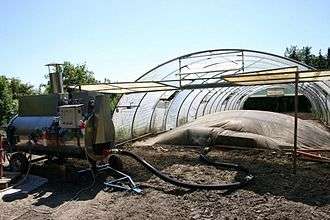
Soil steaming can be used as an alternative to chemicals for soil sterilization. Different methods are available to induce steam into the soil in order to kill pests and increase soil health.
Solarizing is based on the same principle, used to increase the temperature of the soil to kill pathogens and pests.[70]
Certain plants can be cropped for use as biofumigants, "natural" fumigants, releasing pest suppressing compounds when crushed, ploughed into the soil, and covered in plastic for four weeks. Plants in the Brassicaceae family release large amounts of toxic compounds such as methyl isothiocyanates.[71][72]
Plants
Sustainability may also involve crop rotation.[73] Crop rotation and cover crops prevent soil erosion, by protecting topsoil from wind and water.[24] Effective crop rotation can reduce pest pressure on crops and replenish soil nutrients. This reduces the need for fertilizers and pesticides.[73] Increasing the diversity of crops by introducing new genetic resources can increase yields.[74] Perennial crops reduce the need for tillage and thus help mitigate soil erosion, and may sometimes tolerate drought better, increase water quality and help increase soil organic matter. There are research programs attempting to develop perennial substitutes for existing annual crops, such as replacing wheat with the wild grass Thinopyrum intermedium, or possible experimental hybrids of it and wheat.[75]
Traditional agriculture
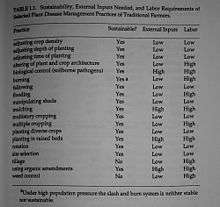
Often thought of as inherently destructive, slash-and-burn or slash-and-char shifting cultivation have been practised in the Amazon for thousands of years.[77]
Some traditional systems combine polyculture with sustainability. In South-East Asia, rice-fish systems on rice paddies have raised freshwater fish as well as rice, producing an additional product and reducing eutrophication of neighbouring rivers.[78] A variant in Indonesia combines rice, fish, ducks and water fern; the ducks eat the weeds that would otherwise limit rice growth, saving labour and herbicides, while the duck and fish manure substitute for fertilizer.[79]
Raised field agriculture has been recently revived in certain areas of the world, such as the Altiplano region in Bolivia and Peru. This has resurged in the form of traditional Waru Waru raised fields, which create nutrient rich soil in regions where such soil is scarce. This method is extremely productive, and has recently been utilized by indigenous groups in the area and the nearby Amazon Basin in order to make use of lands that have been historically hard to cultivate.
In Ohio, some farmers that could not buy land good for agriculture, restored soil considered as unsuitable for any agricultural activity with traditional methods[80]
Alternative agriculture
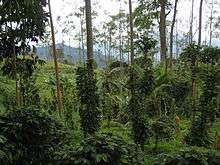
The use of available city space (e.g., rooftop gardens, community gardens, garden sharing, and other forms of urban agriculture) may be able to contribute to sustainability.[81]
There is limited evidence polyculture may contribute to sustainable agriculture. A meta-analysis of a number of polycrop studies found that predator insect biodiversity was higher at comparable yields than conventional in certain two-crop systems with a single cash crop combined with a cover crop.[82]
One approach to sustainability is to develop polyculture systems using perennial crop varieties. Such varieties are being developed for rice, wheat, sorghum, barley, and sunflowers. If these can be combined in polyculture with a leguminous cover crop such as alfalfa, fixation of nitrogen will be added to the system, reducing the need for fertilizer and pesticides.[75]
Organic Agriculture
Organic agriculture can be defined as:
an integrated farming system that strives for sustainability, the enhancement of soil fertility and biological diversity whilst, with rare exceptions, prohibiting synthetic pesticides, antibiotics, synthetic fertilizers, genetically modified organisms, and growth hormones.[83][84][85][86]
Some claim organic agriculture may produce the most sustainable products available for consumers in the US, where no other alternatives exist, although the focus of the organics industry is not sustainability.[73]
In 2018 the sales of organic products in USA reach $52.5 billion[87] According to a big survey two thirds of Americans consume organic products at least occasionally[88]
Regenerative Agriculture
Regenerative agriculture is a conservation and rehabilitation approach to food and farming systems. It focuses on topsoil regeneration, increasing biodiversity,[89] improving the water cycle,[90] enhancing ecosystem services, supporting biosequestration, increasing resilience to climate change, and strengthening the health and vitality of farm soil. Practices include, recycling as much farm waste as possible, and adding composted material from sources outside the farm.[91][92][24][93]
Permaculture
Permaculture does not share the philosophical base as indicated by the title of the 2002 publication Permaculture, principles and pathways beyond sustainability.[94]
Social factors
Rural economic development
In 2007, the United Nations reported on "Organic Agriculture and Food Security in Africa", stating that using sustainable agriculture could be a tool in reaching global food security without expanding land usage and reducing environmental impacts.[21] There has been evidence provided by developing nations from the early 2000s stating that when people in their communities are not factored into the agricultural process that serious harm is done. The social scientist Charles Kellogg has stated that, "In a final effort, exploited people pass their suffering to the land."[21] Sustainable agriculture mean the ability to permanently and continuously "feed its constituent populations."[21]
There are a lot of opportunities that can increase farmers’ profits, improve communities, and continue sustainable practices. For example, in Uganda Genetically Modified Organisms were originally illegal, however, with the stress of banana crisis in Uganda where Banana Bacterial Wilt had the potential to wipe out 90% of yield they decided to explore GMOs as a possible solution.[95] The government issued the National Biotechnology and Biosafety bill which will allow scientists that are part of the National Banana Research Program to start experimenting with genetically modified organisms.[96] This effort has the potential to help local communities because a significant portion live off the food they grow themselves and it will be profitable because the yield of their main produce will remain stable.
Not all regions are suitable for agriculture.[91][67] The technological advancement of the past few decades has allowed agriculture to develop in some of these regions. For example, Nepal has built greenhouses to deal with its high altitude and mountainous regions.[24] Greenhouses allow for greater crop production and also use less water since they are closed systems.[97]
Desalination techniques can turn salt water into fresh water which allows greater access to water for areas with a limited supply.[98] This allows the irrigation of crops without decreasing natural fresh water sources.[99] While desalination can be a tool to provide water to areas that need it to sustain agriculture, it requires money and resources. Regions of China have been considering large scale desalination in order to increase access to water, but the current cost of the desalination process makes it impractical.[100]
Women
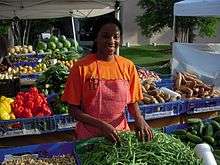
Women working in sustainable agriculture come from numerous backgrounds, from academic and labour.[101] In the past 30 years (1978-2007) in the United States the number of women farm operators has tripled.[91] Today, women operate 14 percent of farms, compared to five percent in 1978. Much of the growth is due to women farming outside the "male dominated field of conventional agriculture".[91]
Growing your own food
The practice of growing food in the backyard of houses, schools, etc., by families or by communities became widespread in the USA at the time of world war one, the great recession and world war two, so that in one point of time 40% of the vegetables of the USA was produced in this way. The practice became more popular again in the time of the COVID-19 pandemic. This method permits to grow food in a relatively sustainable way and at the same time make easier for poor people to obtain food[102].
Policy
Sustainable agriculture is a topic in international policy concerning its potential to reduce environmental risks. In 2011, the Commission on Sustainable Agriculture and Climate Change, as part of its recommendations for policy makers on achieving food security in the face of climate change, urged that sustainable agriculture must be integrated into national and international policy.[103] The Commission stressed that increasing weather variability and climate shocks will negatively affect agricultural yields, necessitating early action to drive change in agricultural production systems towards increasing resilience.[103] It also called for dramatically increased investments in sustainable agriculture in the next decade, including in national research and development budgets, land rehabilitation, economic incentives, and infrastructure improvement.[103]
One of the most important projects to mitigate climate change with agriculture and adapting agriculture to climate change at the same time, was launched in 2019 by the "Global EverGreening Alliance". The initiative was announced in the 2019 UN Climate Action Summit. One of the main methods is Agroforestry. Another important method is Conservation farming. One of the targets is to sequester carbon from the atmosphere. By 2050 the restored land should sequestrate 20 billion tonnes of carbon annually. The coalition wants, among other, to recover with trees a territory of 5.75 million square kilometres, achieve a health tree - grass balance on a territory of 6.5 million square kilometres and increase carbon capture in a territory of 5 million square kilometres.
The first phase is the "Grand African Savannah Green Up" project. Already millions families implemented these methods, and the average territory covered with trees in the farms in Sahel increased to 16%.[104]
The Alliance work on the issue of sustainable agriculture since 2012[105]
European Union
In May 2020 the European Union published a program, named "From Farm to Fork" for making its agriculture more sustainable. In the official page of the program From Farm to Fork is cited Frans Timmermans the Executive Vice-President of the European Commission, saying that:
"The coronavirus crisis has shown how vulnerable we all are, and how important it is to restore the balance between human activity and nature. At the heart of the Green Deal the Biodiversity and Farm to Fork strategies point to a new and better balance of nature, food systems and biodiversity; to protect our people’s health and well-being, and at the same time to increase the EU’s competitiveness and resilience. These strategies are a crucial part of the great transition we are embarking upon."[106]
The program include the next targets:
- Making 25% of EU agriculture organic, by the year 2030.
- Reduce by 50% the use of Pesticides by the year 2030.
- Reduce the use of Fertilizers by 20% by the year 2030.
- Reduce nutrient loss by at least 50%.
- Reduce the use of antimicrobials in agriculture and antimicrobials in aquaculture by 50% by 2030.
- Create sustainable food labeling.
- Reduce food waste by 50% by 2030.
- Dedicate to R&I related to the issue €10 billion.[106]
China
In 2016, the Chinese government adopted a plan to reduce China's meat consumption by 50%, for achieving more sustainable and healthy food system.[107][108]
United States
In the United States, the federal USDA-Natural Resources Conservation Service provides technical and financial assistance for those interested in pursuing natural resource conservation along with production agriculture.[109]
Criticism
Among 63 farmers interviewed in Tasmania most accepted the notion climate change was happening, but just a small segment believed that it was human related. Few farmers thought that the issue of climate change was significant enough to diminish what was causing it. Some of the farmers were worried about how a suggested carbon dioxide reduction plan would affect the agricultural sector and were suspicious of numerous government related activities, seeing them as methods in which the government could punish producers.[110] The author James Howard Kunstler claims almost all modern technology is bad and that there cannot be sustainability unless agriculture is done in ancient traditional ways.[111] Efforts toward more sustainable agriculture are supported in the sustainability community, however, these are often viewed only as incremental steps and not as an end. Some foresee a true sustainable steady state economy that may be very different from today's: greatly reduced energy usage, minimal ecological footprint, fewer consumer packaged goods, local purchasing with short food supply chains, little processed foods, more home and community gardens, etc.[112]
According to Michael Carolan, a major barrier to the adoption of sustainable agriculture is its appearance of a lack of benefits. Many benefits are not visible or immediately evident, and affecting changes such as lower rates of soil and nutrient loss, improved soil structure and higher levels of beneficial microorganisms takes time.[113] In conventional agriculture the benefits are easily visible with no weeds, pests, etc. and the costs to soil and ecosystems around it are hidden and "externalised".[113]
See also
Sources
![]()
References
- "What is sustainable agriculture | Agricultural Sustainability Institute". asi.ucdavis.edu. 11 December 2018. Retrieved 2019-01-20.
- "Introduction to Sustainable Agriculture". Ontario Ministry of Agriculture, Food and Rural Affairs. 2016. Retrieved 10 October 2019.
- Brown, L. R. (2012). World on the Edge. Earth Policy Institute. Norton. ISBN 978-1-136-54075-2.
- Rockström, Johan; Williams, John; Daily, Gretchen; Noble, Andrew; Matthews, Nathanial; Gordon, Line; Wetterstrand, Hanna; DeClerck, Fabrice; Shah, Mihir (2016-05-13). "Sustainable intensification of agriculture for human prosperity and global sustainability". Ambio. 46 (1): 4–17. doi:10.1007/s13280-016-0793-6. PMC 5226894. PMID 27405653.
- King, Franklin H. (2004). Farmers of forty centuries. Retrieved 20 February 2016.
- Rural Science Graduates Association (2002). "In Memo rium - Former Staff and Students of Rural Science at UNE". University of New England. Archived from the original on 6 June 2013. Retrieved 21 October 2012.
- Kirschenmann, Frederick. A Brief History of Sustainable Agriculture, editor's note by Carolyn Raffensperger and Nancy Myers. The Networker, vol. 9, no. 2, March 2004.
- Bertschinger, L. et al. (eds) (2004). Conclusions from the 1st Symposium on Sustainability in Horticulture and a Declaration for the 21st Century. In: Proc. XXVI IHC – Sustainability of Horticultural Systems. Acta Hort. 638, ISHS, pp. 509-512. Retrieved on: 2009-03-16.
- Lal, R. (2008). Sustainable Horticulture and Resource Management. In: Proc. XXVII IHC-S11 Sustainability through Integrated and Organic Horticulture. Eds.-in-Chief: R.K. Prange and S.D. Bishop. Acta Hort.767, ISHS, pp. 19-44.
- "National Agricultural Research, Extension, and Teaching Policy Act of 1977" (PDF). US Department of Agriculture. 13 November 2002.

- Pretty, Jules N. (March 2008). "Agricultural sustainability: concepts, principles and evidence". Philosophical Transactions of the Royal Society of London B: Biological Sciences. 363 (1491): 447–465. doi:10.1098/rstb.2007.2163. ISSN 0962-8436. PMC 2610163. PMID 17652074.
- Stenholm, Charles; Waggoner, Daniel (February 1990). "Low-input, sustainable agriculture: Myth or method?". Journal of Soil and Water Conservation. 45 (1): 14. Retrieved 3 March 2016.
- Tomich, Tom (2016). Sustainable Agriculture Research and Education Program (PDF). Davis, California: University of California.
- Chrispeels, M. J.; Sadava, D. E. (1994). Farming Systems: Development, Productivity, and Sustainability. Plants, Genes, and Agriculture. Jones and Bartlett. pp. 25–57. ISBN 978-0867208719.
- Robinson, Guy M. (2009-09-01). "Towards Sustainable Agriculture: Current Debates". Geography Compass. 3 (5): 1757–1773. doi:10.1111/j.1749-8198.2009.00268.x. ISSN 1749-8198.
- Huang, Jiao; Tichit, Muriel; Poulot, Monique; Darly, Ségolène; Li, Shuangcheng; Petit, Caroline; Aubry, Christine (2014-10-16). "Comparative review of multifunctionality and ecosystem services in sustainable agriculture". Journal of Environmental Management. 149: 138–147. doi:10.1016/j.jenvman.2014.10.020. PMID 25463579.
- Renting, H.; Rossing, W.A.H.; Groot, J.C.J; Van der Ploeg, J.D.; Laurent, C.; Perraud, D.; Stobbelaar, D.J.; Van Ittersum, M.K. (2009-05-01). "Exploring multifunctional agriculture. A review of conceptual approaches and prospects for an integrative transitional framework". Journal of Environmental Management. 90: S112–S123. doi:10.1016/j.jenvman.2008.11.014. ISSN 0301-4797. PMID 19121889.
- Tilman, David; Cassman, Kenneth G.; Matson, Pamela A.; Naylor, Rosamond; Polasky, Stephen (2002-08-08). "Agricultural sustainability and intensive production practices". Nature. 418 (6898): 671–677. Bibcode:2002Natur.418..671T. doi:10.1038/nature01014. PMID 12167873.
- Sandhu, Harpinder S.; Wratten, Stephen D.; Cullen, Ross (2010-02-01). "Organic agriculture and ecosystem services". Environmental Science & Policy. 13 (1): 1–7. doi:10.1016/j.envsci.2009.11.002. ISSN 1462-9011.
- Altieri, Miguel A. (1995) Agroecology: The science of sustainable agriculture. Westview Press, Boulder, CO.
- Stanislaus, Dundon (2009). "Sustainable Agriculture". Gale Virtual Reference Library.
- "Scientists discover genetics of nitrogen fixation in plants - potential implications for future agriculture". News.mongabay.com. 2008-03-08. Retrieved 2013-09-10.
- Proceedings of the National Academy of Sciences of the United States of America, March 25, 2008 vol. 105 no. 12 4928–4932
- Atekan, A.; Nuraini, Y.; Handayanto, E.; Syekhfani, S. (2014-07-07). "The potential of phosphate solubilizing bacteria isolated from sugarcane wastes for solubilizing phosphate". Journal of Degraded and Mining Lands Management. 1 (4): 175–182. doi:10.15243/jdmlm.2014.014.175.
- Khan, Mohammad Saghir; Zaidi, Almas; Wani, Parvaze A. (2007-03-01). "Role of phosphate-solubilizing microorganisms in sustainable agriculture — A review" (PDF). Agronomy for Sustainable Development. 27 (1): 29–43. doi:10.1051/agro:2006011. ISSN 1774-0746.
- Cordell, Dana; White, Stuart (2013-01-31). "Sustainable Phosphorus Measures: Strategies and Technologies for Achieving Phosphorus Security". Agronomy. 3 (1): 86–116. doi:10.3390/agronomy3010086.
- Sharma, Seema B.; Sayyed, Riyaz Z.; Trivedi, Mrugesh H.; Gobi, Thivakaran A. (2013-10-31). "Phosphate solubilizing microbes: sustainable approach for managing phosphorus deficiency in agricultural soils". SpringerPlus. 2: 587. doi:10.1186/2193-1801-2-587. PMC 4320215. PMID 25674415.
- Bhattacharya, Amitav (2019). "Chapter 5 - Changing Environmental Condition and Phosphorus-Use Efficiency in Plants". Changing Climate and Resource Use Efficiency in Plants. Academic Press. pp. 241–305. doi:10.1016/B978-0-12-816209-5.00005-2. ISBN 978-0-12-816209-5.
- Green, B.W. (2015). "2 - Fertilizers in aquaculture". Feed and Feeding Practices in Aquaculture. Woodhead Publishing. pp. 27–52. doi:10.1016/B978-0-08-100506-4.00002-7. ISBN 978-0-08-100506-4.
- IFDC.org - IFDC Report Indicates Adequate Phosphorus Resources, Sep-2010
- Jasinski, SM (January 2017). Mineral Commodity Summaries (PDF). U.S. Geological Survey.
- Van Kauwenbergh, Steven J. (2010). World Phosphate Rock Reserves and Resources. Muscle Shoals, AL, USA: International Fertilizer Development Center (IFDC). p. 60. ISBN 978-0-88090-167-3. Retrieved 7 April 2016.
- Edixhoven, J.D.; Gupta, J.; Savenije, H.H.G. (2013). "Recent revisions of phosphate rock reserves and resources: reassuring or misleading? An in-depth literature review of global estimates of phosphate rock reserves and resources". Earth System Dynamics. 5 (2): 491–507. Bibcode:2014ESD.....5..491E. doi:10.5194/esd-5-491-2014.
- Cordell, Dana (2009). "The story of phosphorus: Global food security and food for thought". Global Environmental Change. 19 (2): 292–305. doi:10.1016/j.gloenvcha.2008.10.009.
- Cordell, Dana & Stuart White 2011. Review: Peak Phosphorus: Clarifying the Key Issues of a Vigorous Debate about Long-Term Phosphorus Security. Sustainability 2011, 3(10), 2027-2049; doi:10.3390/su3102027, http://www.mdpi.com/2071-1050/3/10/2027/htm
- Summary for Policymakers. In: Climate Change and Land: an IPCC special report on climate change, desertification, land degradation, sustainable land management, food security, and greenhouse gas fluxes in terrestrial ecosystems (PDF). Intergovernmental Pannel on Climate Change. 2019. p. 5. Retrieved 30 January 2020.
- "CEP Factsheet". Musokotwane Environment Resource Centre for Southern Africa. Archived from the original on 2013-02-13.
- Powlson, D.S.; Gregory, P.J.; Whalley, W.R.; Quinton, J.N.; Hopkins, D.W.; Whitmore, A.P.; Hirsch, P.R.; Goulding, K.W.T. (2011-01-01). "Soil management in relation to sustainable agriculture and ecosystem services". Food Policy. 36: S72–S87. doi:10.1016/j.foodpol.2010.11.025.
- Principles of sustainable soil management in agroecosystems. Lal, R., Stewart, B. A. (Bobby Alton), 1932-. CRC Press. 2013. ISBN 978-1466513471. OCLC 768171461.CS1 maint: others (link)
- Gliessman, Stephen (2015). Agroecology: the ecology of sustainable food systems. Boca Raton: CRC Press. ISBN 978-1439895610. OCLC 744303838.
- Mohawesh, Yasser; Taimeh, Awni; Ziadat, Feras (September 2015). "Effects of land use changes and soil conservation intervention on soil properties as indicators for land degradation under a Mediterranean climate". Solid Earth. 6 (3): 857–868. Bibcode:2015SolE....6..857M. doi:10.5194/se-6-857-2015.
- Grimble, Robin (April 2002). "Rural Poverty and Environmental Management : A framework for understanding". Transformation: An International Journal of Holistic Mission Studies. 19 (2): 120–132. doi:10.1177/026537880201900206. OCLC 5724786521.
- Barbier, Edward B.; Hochard, Jacob P. (May 11, 2016). "Does Land Degradation Increase Poverty in Developing Countries?". PLOS ONE. 11 (5): e0152973. Bibcode:2016PLoSO..1152973B. doi:10.1371/journal.pone.0152973. PMC 4864404. PMID 27167738.
- "Science points to causes of COVID-19". United Nations Environmental Programm. United Nations. Retrieved 24 June 2020.
- Carrington, Damian (17 June 2020). "Pandemics result from destruction of nature, say UN and WHO". The Guardian. Retrieved 24 June 2020.
- Thomson, Amanda; Simpson, Ian; Brown, Jennifer (October 2005). "Sustainable rangeland grazing in Norse Faroe" (PDF). Human Ecology. 33 (5): 737–761. doi:10.1007/s10745-005-7596-x. hdl:1893/132.
- "FAO World Agriculture towards 2015/2030". Food and Agriculture Organization. 21 August 2008.
- "FAO World Agriculture towards 2015/2030". Fao.org. Retrieved 2013-09-10.
- "FAO 2011 Energy Smart Food" (PDF). Retrieved 2013-09-10.
- Sarkodie, Samuel A.; Ntiamoah, Evans B.; Li, Dongmei (2019). "Panel heterogeneous distribution analysis of trade and modernized agriculture on CO2 emissions: The role of renewable and fossil fuel energy consumption". Natural Resources Forum. 43 (3): 135–153. doi:10.1111/1477-8947.12183. ISSN 1477-8947.
- "Advances in Sustainable Agriculture: Solar-powered Irrigation Systems in Pakistan". McGill University. 2014-02-12. Retrieved 2014-02-12.
- "Urban Agriculture: Practices to Improve Cities". 2011-01-18.
- "What is Sustainable Agriculture? — ASI". Sarep.ucdavis.edu. Archived from the original on 2007-04-21. Retrieved 2013-09-10.
- "Indicators for sustainable water resources development". Fao.org. Retrieved 2013-09-10.
- Netting, Robert McC. (1993) Smallholders, Householders: Farm Families and the Ecology of Intensive, Sustainable Agriculture. Stanford Univ. Press, Palo Alto.
- "Beyond the limits: global collapse or a sustainable future".
- Glover, Jerry D.; Cox, Cindy M.; Reganold, John P. (2007). "Future Farming: A Return to Roots?" (PDF). Scientific American. 297 (2): 82–89. Bibcode:2007SciAm.297b..82G. doi:10.1038/scientificamerican0807-82. PMID 17894176. Retrieved 2013-09-10.
- Mortensen, David (January 2012). "Navigating a Critical Juncture for Sustainable Weed Management" (PDF). BioScience. 62: 75–84. doi:10.1525/bio.2012.62.1.12.
- Field Crops Res. 34:239
- "Pastures: Sustainable Management". Attra.ncat.org. 2013-08-05. Archived from the original on 2010-05-05. Retrieved 2013-09-10.
- Pretty. J. (November 23, 2018). Intensification for redesigned and sustainable agriculture systems; http://science.sciencemag.org/content/362/6417/eaav0294/tab-pdf
- Gurr, Geoff M.; et al. (2016). "Multi-country evidence that crop diversification promotes ecological intensification of agriculture". Nature Plants. 2 (3): 16014. doi:10.1038/nplants.2016.14. PMID 27249349.
- Marks, Paul (15 January 2014). "Vertical farms sprouting all over the world". New Scientist. Retrieved 8 March 2018.
- MEI, Xu-rong; ZHONG, Xiu-li; Vincent, Vadez; LIU, Xiao-ying (2013-07-01). "Improving Water Use Efficiency of Wheat Crop Varieties in the North China Plain: Review and Analysis" (PDF). Journal of Integrative Agriculture. 12 (7): 1243–1250. doi:10.1016/S2095-3119(13)60437-2.
- Hu, Honghong; Xiong, Lizhong (2014-01-01). "Genetic Engineering and Breeding of Drought-Resistant Crops". Annual Review of Plant Biology. 65 (1): 715–41. doi:10.1146/annurev-arplant-050213-040000. PMID 24313844.
- Mitchell, Jeffrey P.; Singh, Purnendu N.; Wallender, Wesley W.; Munk, Daniel S.; Wroble, Jon F.; Horwath, William R.; Hogan, Philip; Roy, Robert; Hanson, Blaine R. (April 2012). "No-tillage and high-residue practices reduce soil water evaporation" (PDF). California Agriculture. 66 (2): 55–61. doi:10.3733/ca.v066n02p55.
- KAUR, Gurdeep; REDDY, Mondem Sudhakara (2015). "Effects of Phosphate-Solubilizing Bacteria, Rock Phosphate and Chemical Fertilizers on Maize-Wheat Cropping Cycle and Economics". Pedosphere. 25 (3): 428–437. doi:10.1016/s1002-0160(15)30010-2.
- Plant relationships. Carroll, George C., 1940-, Tudzynski, P. (Paul). Berlin: Springer. 1997. ISBN 9783662103722. OCLC 679922657.CS1 maint: others (link)
- Shenoy, V.V.; Kalagudi, G.M. (2005). "Enhancing plant phosphorus use efficiency for sustainable cropping". Biotechnology Advances. 23 (7–8): 501–513. doi:10.1016/j.biotechadv.2005.01.004. PMID 16140488.
- "Soil Solarization". Rodale's Organic Life. Retrieved 14 February 2016.
- "Archived copy" (PDF). Archived from the original (PDF) on 2017-05-17. Retrieved 2015-10-20.CS1 maint: archived copy as title (link)
- "Plant Production and Protection Division - Biofumigation". Food and Agriculture Organization. 2019. Retrieved 12 October 2019.
- "What is Sustainable Agriculture?". Union of Concerned Scientists. 10 April 2017. Retrieved 29 October 2019.
- Global plan of action for the conservation and sustainable utilization of plant genetic resources for food and agriculture ; and, The Leipzig declaration. Rome: Rome : Food and Agriculture Organization of the United Nations. 1996. ISBN 978-9251040270.
- Baker, Beth (2017). "Can Modern Agriculture Be Sustainable?". BioScience. 67 (4): 325–331. doi:10.1093/biosci/bix018. ISSN 0006-3568.
- Thurston, H. David (1992). Sustainable practices for plant disease management in traditional farming systems. Boulder, Colorado: Westview Press. p. 11. ISBN 978-0813383637.
- Sponsel, Leslie E (1986). "Amazon ecology and adaptation". Annual Review of Anthropology. 15: 67–97. doi:10.1146/annurev.anthro.15.1.67.
- Burchett, Stephen; Burchett, Sarah (2011). Introduction to Wildlife Conservation in Farming. John Wiley & Sons. p. 268. ISBN 978-1-119-95759-1.
- Bezemer, Marjolein (12 December 2018). "Mixed farming increases rice yield". reNature Foundation.
- "Ohio Farmers Use Old-Fashioned Methods to Turn Degraded Land into Green Pasture". Yale Climate Connections. Ecowatch. November 8, 2019. Retrieved 10 November 2019.
- Viljoen, Andre; Howe, Joe, eds. (2005). Continuous Productive Urban Landscapes : Designing Urban Agriculture for Sustainable Cities. Taylor & Francis. ISBN 9781136414329. OCLC 742299840.
- Iverson, Aaron L.; Marín, Linda E.; Ennis, Katherine K.; Gonthier, David J.; Connor-Barrie, Benjamin T.; Remfert, Jane L.; Cardinale, Bradley J.; Perfecto, Ivette (2014). "REVIEW: Do polycultures promote win-wins or trade-offs in agricultural ecosystem services? A meta-analysis". Journal of Applied Ecology. 51 (6): 1593–1602. doi:10.1111/1365-2664.12334.
- Danielle Treadwell, Jim Riddle, Mary Barbercheck, Deborah Cavanaugh-Grant, Ed Zaborski, Cooperative Extension System, What is organic farming?
- H. Martin, '’Ontario Ministry of Agriculture, Food and Rural Affairs Introduction to Organic Farming, ISSN 1198-712X
- Dale Rhoads, Purdue Extension Service, What is organic farming?
- Gold, Mary. "What is organic production?". National Agricultural Library. USDA. Retrieved 1 March 2014.
- Gelski, Jeff (20 May 2019). "U.S. annual organic food sales near $48 billion". Food Business News. Retrieved 19 December 2019.
- "Organic Market Overview". United States Department of Agriculture Economic Research Service. Retrieved 19 December 2019.
- "Our Sustainable Future - Regenerative Ag Description". csuchico.edu. Retrieved 2017-03-09.
- Underground, The Carbon; Initiative, Regenerative Agriculture; CSU (2017-02-24). "What is Regenerative Agriculture?". Regeneration International. Retrieved 2017-03-09.
- Pilgeram, Ryanne (2015). "Beyond 'Inherit It or Marry It': Exploring How Women Engaged in Sustainable Agriculture Access Farmland". Academic Search Complete. Retrieved 13 March 2017.
- "Regenerative Agriculture | Regenerative Agriculture Foundation". regenerativeagriculturefoundation.org. Retrieved 2017-03-09.
- "Regenerative Organic Agriculture | ORGANIC INDIA". us.organicindia.com. Retrieved 2017-03-09.
- Holmgren, D. (2002). Permaculture, principles and pathways beyond sustainability. Holmgren Design Services, Hepburn, Australia. ISBN 0-646-41844-0
- Harper, Glyn; Hart, Darren; Moult, Sarah; Hull, Roger (2004). "Banana streak virus is very diverse in Uganda". Virus Research. 100 (1): 51–56. doi:10.1016/j.virusres.2003.12.024. PMID 15036835.
- Tripathi, Leena; Atkinson, Howard; Roderick, Hugh; Kubiriba, Jerome; Tripathi, Jaindra N. (2017). "Genetically engineered bananas resistant to Xanthomonas wilt disease and nematodes". Food and Energy Security. 6 (2): 37–47. doi:10.1002/fes3.101. PMC 5488630. PMID 28713567.
- Stacey, Neil; Fox, James; Hildebrandt, Diane (2018-02-14). "Reduction in greenhouse water usage through inlet CO2 enrichment". AIChE Journal. 64 (7): 2324–2328. doi:10.1002/aic.16120. ISSN 0001-1541.
- Chaibi, M. T. (2000). "An overview of solar desalination for domestic and agriculture water needs in remote arid areas". Desalination. 127 (2): 119–133. doi:10.1016/s0011-9164(99)00197-6.
- Shaffer, Devin; Yip, Ngai (2012-10-01). "Seawater desalination for agriculture by integrated forward and reverse osmosis: Improved product water quality for potentially less energy". Journal of Membrane Science. 415–416: 1–8. doi:10.1016/j.memsci.2012.05.016. ISSN 0376-7388.
- Zhou, Y.; Tol, R. S. (2004). "Implications of desalination for water resources in China—an economic perspective". Desalination. 164 (3): 225–240. doi:10.1016/s0011-9164(04)00191-2.
- AGRIBLE. (January 4, 2017). Women in Sustainable Agriculture; https://about.agrible.com/agnews/2017/1/3/women-in-sustainable-agriculture
- Robbins, Ocean. "Starting a Food Garden: How Growing Your Own Vegetables Can Ease Food Supply Anxiety & Support Health". Food Revolution Network. Retrieved 8 June 2020.
- "Achieving food security in the face of climate change: Summary for policy makers from the Commission on Sustainable Agriculture and Climate Change" (PDF). CGIAR Research Program on Climate Change, Agriculture and Food Security (CCAFS). November 2011.
- Hoffner, Erik (October 25, 2019). "Grand African Savannah Green Up': Major $85 Million Project Announced to Scale up Agroforestry in Africa". Ecowatch. Retrieved 27 October 2019.
- "ABOUT US". The Gloibal Evegreening Alliance. Retrieved 4 November 2019.
- "From Farm to Fork". European Commission website. European Union. Retrieved 26 May 2020.

- Matthew, Bossons. "New Meat: Is China Ready for a Plant-Based Future?". That's. Retrieved 21 June 2020.
- Milman, Oliver; Leavenworth, Stuart (20 June 2016). "China's plan to cut meat consumption by 50% cheered by climate campaigners". The Guardian. Retrieved 21 June 2020.
- Ron Nichols (2019). "The sustainable solutions at our feet". National Resources Conservation Service, US Department of Agriculture. Retrieved 29 October 2019.
- Fleming, A. Vanclay, F. (August 3rd, 2009);Farmer responses to climate change and sustainable agriculture. A review; https://hal.archives-ouvertes.fr/hal-00886547/document
- Kunstler, James Howard (2012). Too Much Magic; Wishful Thinking, Technology, and the Fate of the Nation. Atlantic Monthly Press. ISBN 978-0-8021-9438-1.
- McKibben, D., ed. (2010). The Post Carbon Reader: Managing the 21st Century Sustainability Crisis. Watershed Media. ISBN 978-0-9709500-6-2.
- Carolan, Michael (2006). "Do You See What I See? Examining the Epistemic Barriers to Sustainable Agriculture". Academic Search Complete. Retrieved 13 March 2017.
Further reading
| Wikimedia Commons has media related to Sustainable agriculture. |
- Dore, J. (1997) Sustainability Indicators for Agriculture: Introductory Guide to Regional/National and On-farm Indicators, Rural Industries Research and Development Corporation, Australia.
- Falvey, Lindsay (2004) Sustainability – Elusive or Illusion: Wise Environmental Management. Institute for International Development, Adelaide.
- Gold, Mary (1999) Sustainable Agriculture: Definitions and Terms. Special Reference Briefs Series no. SRB 99-02 Updates SRB 94-5 September 1999. National Agricultural Library, Agricultural Research Service, U.S. Department of Agriculture.
- National Academies of Sciences, Engineering, and Medicine (2019) Negative Emissions Technologies and Reliable Sequestration: A Research Agenda.
- Paull, J. (2014) Lord Northbourne, the man who invented organic farming, a biography. Journal of Organic Systems, 9(1), 31–53.
- Pender J., Place F., Ehui S. (2006) Strategies for Sustainable Land Management in the East African Highlands
- Pollan M. (2007) The Omnivore's Dilemma: A Natural History of Four Meals
- Roberts W. (2008) The No-Nonsense Guide to World Food
- Royal Society (February 2008) permanent dead link] Dedicated double issue of Philosophical Transactions B on Sustainable Agriculture. Some articles are freely available.
